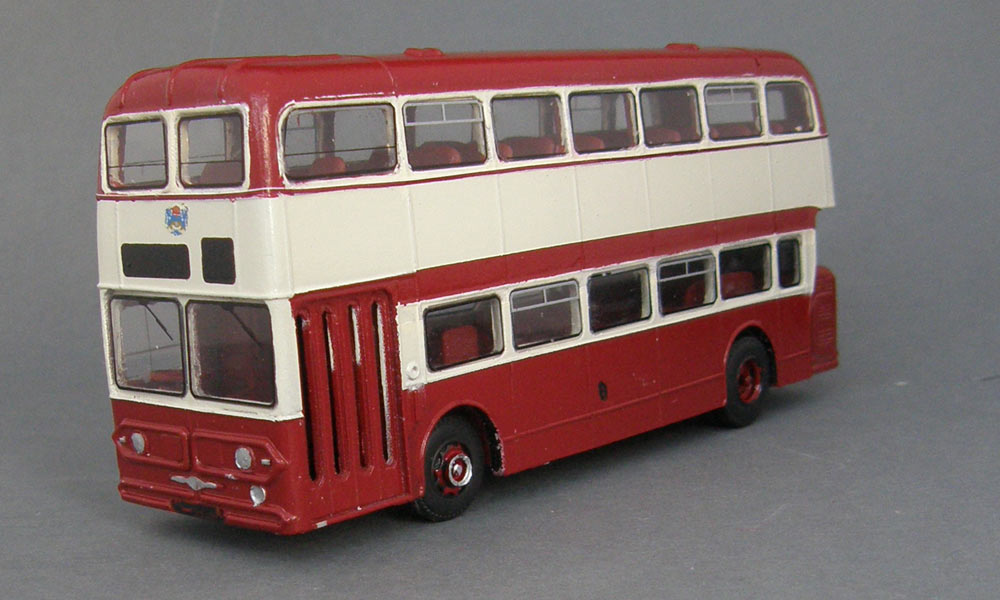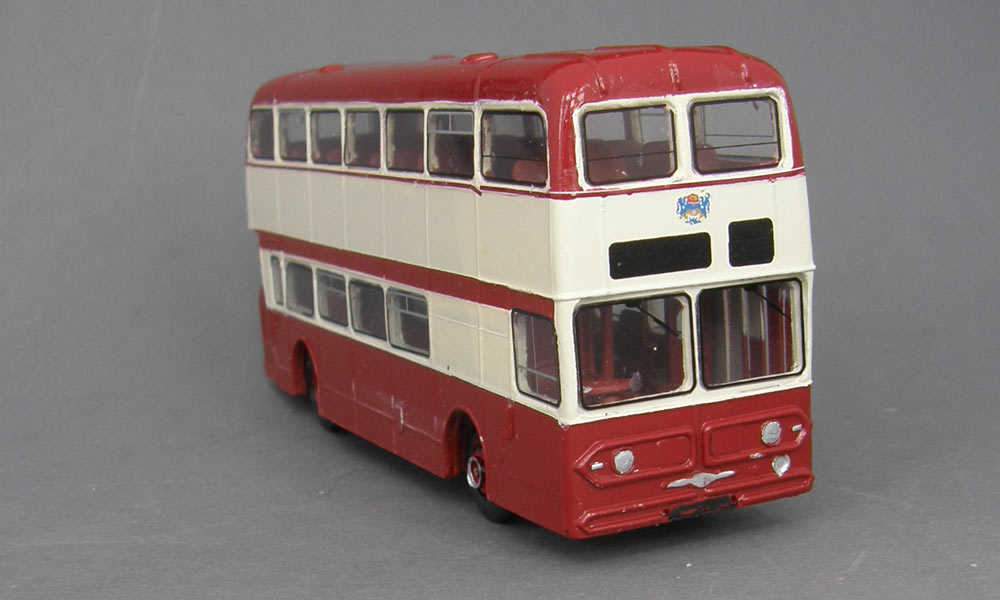 |
 |
LITTLE BUS COMPANY 6 Appleyard, Haworth Close, Halifax, HX1 2NN. Tel: 01422 301600 E-mail: |
 |
 |
LITTLE BUS COMPANY 6 Appleyard, Haworth Close, Halifax, HX1 2NN. Tel: 01422 301600 E-mail: |
|
|
|
|
|
1965 DAIMLER FLEETLINE (or 1964 LEYLAND PDR1/2 ATLANTEAN) - DOUBLE DECK, WILLOWBROOK LOW HEIGHT (14’ 0”) BODY - COVENTRY CORPORATION TRANSPORT
The kit is based on Willowbrook drawing 8927 for the Coventry Fleetline, kindly provided to LBC by Phil Norris. Minor detail alterations need to be made for the Atlanteans, for which an alternative engine bustle is provided. In summary, the buses, which could be represented by this kit, are:
Coventry Corporation Transport There are plenty of references to the Coventry Willowbrook Atlanteans and Fleetlines, not least in “Classic Bus” Nos 49 and 50, but a little book “Coventry Transport Part Two” by Denton & Groves (BTHG 1987), which I found at the Aston Manor Museum, came in handy. “Daimler Rear Engined Buses” by Stewart J Brown (Bus Enthusiast Publishing Co, 1985) has a superb cover picture of Coventry Fleetline 372 in the later “Shetland Ivory” and “Marshall Red” livery. To model the Coventry Atlanteans, the alternative Atlantean bustle needs to be used instead of the Daimler and an Atlantean badge needs to be added above the upper moulding on the front dash and the Daimler fluted badge removed. Atlanteans did not have the additional fuel filler (originally covered with a flap) ahead of the offside front wheel and the oblong side lights at the front need to be replaced by round ones. The “flashers” on the Atlanteans were of the more rounded “teardrop” style. Destination screens consisted front and rear of two 29” by 8” destination and “via” screens, mounted above each other, with a separate 18” by 12” route number screen at the nearside at the front and at the offside rear. In later years the flaps over the fuel fillers were removed and the style of the side lights, trafficators and destination screens were also changed. Reference should be made to photographs for the appropriate period. These changes appear to coincide with the repainting in 1970/71 into the brighter “Marshall Red” and “Shetland Ivory” livery. East Anglia and Lincolnshire The Whippet and The Delaine Atlanteans are similar to the Coventry ones, but need some extra trim and beading, (and removal of the panel beading on the lower deck skirt) which can be made from 5 x 10 thou’ styrene or just painted or transferred on. Detail changes also need to be made to the front dash and the location and style of the Atlantean badge (which is at the bottom of the dash) and the fog lights (these had oblong side lights!). The Delaine’s DTL 489D lives on in preservation. Burwell & District’s first Fleetline, 9 DER, was a former demonstrator and its Willowbrook body lacked the distinctive fluting on the front dash and the strengthening ribs on the roof. The second, DEB 484C, was to full Coventry specification, including the style of the front destination and route indicators. “Super Prestige No 12 – Cambridge 2”, by Paul Carter (Venture Publications, 2007) covers the Burwell & District and Whippet buses. Grimsby-Cleethorpes Transport Joint Committee
The
Grimsby-Cleethorpes Fleetlines were almost identical to the Coventry buses,
except that there are differences in the location of the opening windows and
the layout of the destination screens. Location of fog and side lights and
flashing indicators, together with their style, seems to have varied, but
that may have been due to modifications over time. They had a rear route
number indicator on the bulkhead above the engine bustle, located on the
near side. They also had illuminated advertising displays on the off side. Photographs of built kits are shown below: |
|||||||||||||||||||||||||||||||||||||||||||||||||||||||
 |
 |
|||||||||||||||||||||||||||||||||||||||||||||||||||||||
 |
||||||||||||||||||||||||||||||||||||||||||||||||||||||||
|
Modelling Notes The kit may include two rear bulkhead panels. This model requires the shallower 10mm version, which should be fitted flush with the body sides and resting against the ceiling cove panels of the upper deck floor. This should be fitted after the upper deck floor is in place and the bevelled edge goes at the bottom. A particular note in assembling this model is that the upper deck windows are half a millimetre taller than those in the lower deck, so be careful with putting the printed glazing in the right place. Windows The Coventry, Delaine, Whippet and Burwell buses had top sliders in the first and fifth upper deck windows and in the second and fourth on the lower deck. The Coventry Fleetlines had an additional top slider in the middle windows on the upper deck. The Grimsby Cleethorpes buses had top sliders in the second and fourth upstairs windows on both decks, the third and fifth downstairs windows on the offside and the second and fourth downstairs. The driver’s window is of a four panel divided type. Windscreen wipers were mounted at the top of the offside screen and at the bottom of the nearside screen. Coventry Livery
1964 livery A similar style was applied to the Neepsend/East Lancs Fleetlines except that the Arabian Red covered the whole of the front dome (leaving a small ivory area for the side window surrounds) and the midships band “swooped up” to cover the destination screens. In both these styles no “company” lettering was provided, ownership being indicated by the City coat of arms on the lower deck panels below the middle window.
1970 Livery
1973 Livery In both the 1970 and 1973 livery styles, ownership was indicated by Coventry transport lettering in gold on the lower deck body side and the City coat of arms on the front of the upper deck, above the route indicator. Buses also carried a small letter H or S in black above the driver’s windscreen, indicating allocation to Harnall Lane or Sandy Lane Depots.
Happy
Modelling. © Tony Swift, Kirribilli NSW, Australia, 2009. |
||||||||||||||||||||||||||||||||||||||||||||||||||||||||
Check Price and Availability of this Kit This link will take you to the Little Bus
News Page
For a printable Order Form, please click the button below: |
||||||||||||||||||||||||||||||||||||||||||||||||||||||||
© 2001-2013 All rights
reserved.
LBC Models Ltd
Registered in
Registered Office
6 Appleyard, Haworth Close,
Halifax, HX1 2NN.
Please use this link for
Please use this link
if you have had any problems using this website
(Dead links, Photos which do not appear, etc.).